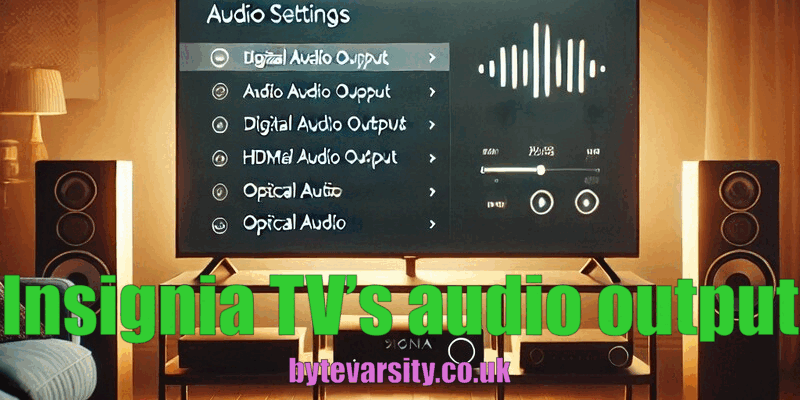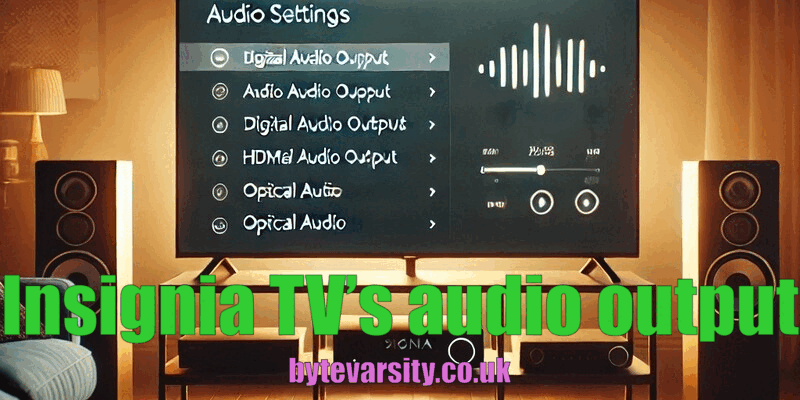Introduction
When it comes to enhancing your Insignia TV’s audio output, there’s no one-size-fits-all solution. The key to an immersive viewing experience lies in adjusting your TV’s sound settings to suit your preferences and setup. Whether you’re watching movies, gaming, or enjoying music, fine-tuning your Insignia TV’s audio settings can dramatically improve sound quality. In this guide, we’ll walk through the most effective methods to optimize audio output on your Insignia TV, ensuring clear and powerful sound that complements your content. We’ll cover everything from HDMI ARC to digital and optical outputs, plus how customizing bass, treble, and equalizer settings can boost your experience. Let’s dive into how you can get the most out of your TV’s audio capabilities.
Understanding Insignia TV Audio Output Options
If you’ve ever wondered what makes your TV sound great, it all boils down to choosing the right audio output setting. Insignia TVs offer several options that can make a noticeable difference in your sound experience. These include digital audio out, HDMI ARC, and optical audio. Each of these choices has its own strengths and specific use cases, so let’s break them down.
Digital Audio Output Settings on Insignia TV
Digital audio output is one of the best options if you’re looking to boost your sound experience. With this setup, you can connect your Insignia TV to a sound system or home theater using a coaxial or optical cable. The beauty of digital audio output lies in its ability to transmit a clean, uncompressed signal, which is perfect for high-quality surround sound.
For those with surround sound setups, this setting is your best friend. If you have a sound system capable of Dolby Atmos or DTS, using digital audio output ensures you get the best sound experience. The process is simple—just connect your digital audio output port to your sound system, and adjust the TV settings to match the output type.

HDMI ARC for Optimal Audio Quality
HDMI ARC (Audio Return Channel) is an excellent choice for anyone who wants to simplify their setup without sacrificing sound quality. By using HDMI ARC, your TV can send audio directly to a compatible sound system or soundbar. This means you don’t have to worry about multiple cables—one HDMI cable handles both audio and video.
Setting up HDMI ARC on your Insignia TV is a breeze. Just connect the HDMI cable from your TV’s ARC-enabled HDMI port to your sound system, then enable HDMI ARC in your TV’s audio settings. Not only will you enjoy better sound, but you also gain the convenience of controlling your TV’s volume with your sound system’s remote.
Using Optical Audio for High-Quality Sound
If you’re after crisp, clear audio without investing in an expensive sound system, optical audio output is a solid option. This connection uses light to transmit the audio signal, which reduces the risk of interference. If you have a soundbar or audio system with an optical input, it’s a fantastic choice for delivering high-fidelity sound.
The setup process is simple: plug one end of the optical cable into the TV’s optical out port and the other into your sound system. Make sure you set your TV’s audio output to optical in the sound settings for a seamless connection. It’s particularly ideal if you want a cleaner sound than standard TV speakers provide without dealing with the hassle of HDMI or coaxial connections.
Customizing Sound Settings on Insignia TV for Enhanced Audio
Beyond just the output connection, tweaking your Insignia TV sound settings is the secret to unlocking optimal audio. From equalizer adjustments to fine-tuning bass and treble, these settings are key to a personalized sound experience that suits your preferences. Let’s explore how customizing these elements can transform your audio quality.
Adjusting Equalizer Settings for Optimal Sound
The equalizer (EQ) settings on your Insignia TV are a powerful tool for adjusting sound frequencies. Whether you’re watching a fast-paced action movie or listening to your favorite playlist, the ability to fine-tune bass, midrange, and treble frequencies can dramatically improve clarity and richness.
To get started, access your TV’s audio settings menu and navigate to the equalizer section. From here, you can raise or lower specific frequencies based on the type of content you’re enjoying. For example, boost the bass for music and movies with heavy sound effects, or adjust the treble to enhance dialogue clarity in a TV show.
Balancing Bass and Treble for Clearer Audio
Balancing bass and treble can be a game-changer for your sound experience. Too much bass can muddy the audio, while too much treble can make it shrill. To get a well-rounded, clear sound, it’s important to adjust these settings carefully.
Start by experimenting with different bass and treble levels based on the type of content you’re consuming. For music, you might prefer a bit more bass to emphasize low-end frequencies, while for TV shows, a neutral treble might make dialogue clearer. In my experience, finding the sweet spot between bass and treble is key to enjoying both music and movies without compromise.
Best Audio Settings for External Speakers or Sound Systems
If you’ve upgraded to external speakers or a sound system, it’s important to fine-tune your TV’s settings to get the best audio experience. Whether you’re using a soundbar or a full home theater system, getting the sync and volume right is crucial for an immersive experience.
Syncing Audio with External Sound Systems
Audio sync is essential when using external sound systems, especially if you’re noticing a lag between the picture and sound. Thankfully, Insignia TVs offer easy-to-access settings that allow you to sync audio with external devices.
To resolve any audio delay, go into your TV’s settings menu, find the audio sync option, and adjust it to match your external system. This ensures that sound matches the action on screen. If you’ve connected via HDMI ARC or optical, these sync settings should work seamlessly.
Volume Control Adjustments for Consistent Output
Maintaining a consistent volume level between your TV’s internal speakers and your external sound system can be tricky. You want to ensure that when you switch between sources, like cable TV or streaming services, the volume remains constant.
On your Insignia TV, you can set the audio to automatically adjust the output volume, so there’s no sudden blasting sound or quiet moments when switching channels or inputs. Keeping the volume level consistent will prevent you from having to constantly fiddle with the remote.
Troubleshooting Common Audio Issues on Insignia TV
Sometimes, things don’t go as planned, and you might run into audio issues like no sound, distorted audio, or sync problems. Here are a few quick fixes to try before you panic.
Fixing No Sound Issues on Insignia TV
One common issue users face is no sound, even when the TV is turned on. If this happens, the first thing you should check is the connection type in the audio settings. Make sure that the correct audio output is selected—whether it’s digital, HDMI ARC, or optical.
Another common culprit is the mute button. It sounds simple, but sometimes it’s the cause of the problem. Ensure that your TV’s volume isn’t accidentally muted or set too low. If the issue persists, try restarting your TV or updating its firmware.
Resolving Audio Delay or Sync Issues
Audio delay, especially when using external sound systems, can be frustrating. This happens when the sound doesn’t match the on-screen action. To fix this, check your TV’s audio delay settings and adjust accordingly. For HDMI ARC setups, ensure that the sound system is compatible with your TV’s sync features.
Dealing with Distorted Sound Output
Distorted sound is often caused by incorrect settings or interference in the audio signal. If you’re experiencing crackling or muffled sound, try resetting your sound settings to their default and adjusting the output type again. If you’re using external speakers, check that cables are securely plugged in and not damaged.
Recommended Audio Settings for Various Content Types
Different types of content—movies, music, gaming—call for different audio settings. Tailoring the sound to suit what you’re watching or playing can enhance your experience significantly.
Best Audio Settings for Movies and Shows
For movies, clarity in dialogue and dynamic range are key. You might want to boost the center channel frequencies for dialogue clarity while enhancing bass for an immersive cinematic feel. These adjustments will help you catch every word and enjoy the full soundscape of your favorite movie scenes.
Optimal Sound Settings for Music Listening
When it comes to music, you want to focus on balance. Boosting the bass and fine-tuning the treble can add depth to tracks. For an immersive listening experience, try enhancing the bass slightly and adjusting the treble to avoid any harshness.
Audio Settings for Gaming on Insignia TV
Gaming demands precise sound to make sure you’re immersed in the experience. Adjust your settings to ensure that explosions and game effects are clear without drowning out dialogue. Also, ensure that sound sync is spot-on for the most accurate experience.
Conclusion
Optimizing your Insignia TV’s audio output settings can make a world of difference in the quality of your sound experience. Whether you’re using internal speakers, a soundbar, or a full home theater setup, tweaking your settings for optimal performance will ensure that you get the best audio possible. Don’t be afraid to experiment with the settings to suit your unique preferences—it’s your sound, after all! So, dive into your TV’s settings today and start enjoying richer, clearer sound that enhances every moment of your viewing experience.
